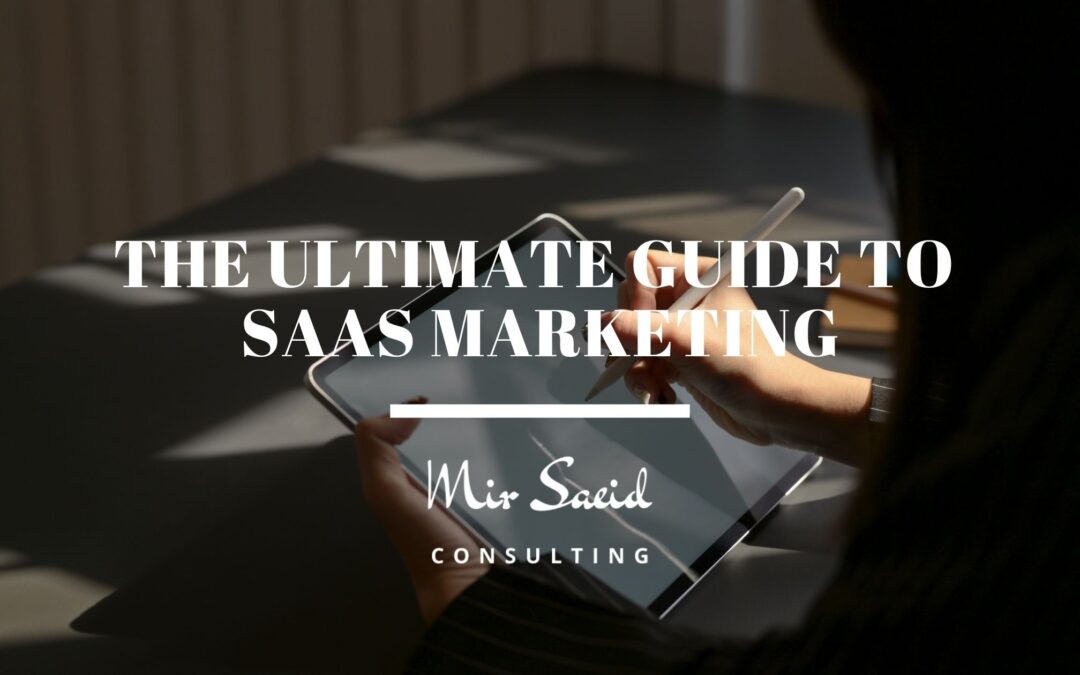As a pure SaaS Business, your website is the most important focus of your marketing. But for other companies, it’s just one of the marketing channels. While other companies want their customers to hand in cash first, you hand out free trials of your products. While others try to convince individuals, your focus is on companies and teams.
SaaS marketing is definitely unique.
I am a person who knows every nook and cranny of SaaS marketing. My professional career focused on building marketing teams for startups and that’s why I think that I have some experience in advising SaaS marketers.
Click to seek my Digital Marketing Consultancy.
What Makes SaaS Marketing Unique?
If, the introduction of my blog did not mean that marketing a SaaS was unique enough, then let me tell you more.
SaaS Marketing is unique because it sells a product as a solution to the problems of a group of people. It is unique because the product is not actually an object but a kind of service and the audience is not a typical consumer but a team or a brand.
You see a SaaS company is majorly a B2B thing.
The crucial challenge in SaaS Marketing is that before closing a sale, there’s the need to get the people of the company to buy into the product. Usually, the sales procedure begins with one person generally, who then promotes the product to the decision-making executives at their company. These decision-making people may not actually use the product.
This means that your main target is not the company but the individual who will advocate for your product. You can offer him solutions for problems at the workplace or give him a free trial of the product. You also need to consider marketing towards the decision-makers who will determine the budget to invest in your products but may have some things to consider before buying the product company-wide.
It comes down to deeply understanding the audience and the individuals — what their behavior is, where they go for information, what do they value, what is it that they need, and what problems do they face in the workplace — and doing targeted marketing to each of the personas in the organization to get them on board.
Working at a SaaS company would mean that you’ll have to be engaged with several customer-facing teams and work closely with them like sales, product, customer success, and other variables that are working on outreaching, providing materials, and organizing campaigns.
Creating a Winning A SaaS Marketing Strategy
There is a common mistake that startup founders make. They choose the option that is comfortable, instead of the one that is better for their product. Your sales will directly depend on your marketing. So, have a marketing strategy, especially if you are a startup that coincides with your audience expectations.
There are four points to consider;
- Cost of your product
- Familiarity of people with your product
- Tech-savviness of your audience
- Ease of on-boarding
Here’s a breakdown of these factors.
Self Serve Model
With the help of this model, teams, organizations, companies or individuals can buy the product themselves and start using the software through the website. This is also called freemium or product-led growth.

Your website acts as a salesperson in this model making it an important area that will require the efforts of your digital marketing team.
The product will take the role of marketing and sales, once your customer is in the product, by upgrading a subscription, continuing, and promoting.
Self-serve can benefit companies that include:
- Products that people are familiar with
- Products that are expensive but easy to get running
- High volume, lower contract value products
- Targeting the people who are busy and already know they want to buy something
- Products that have a simple on-boarding process
Top Down Model
The top-down model includes a traditional way of getting things done like sales are driven by interacting with an actual person. The sales process will take place either on-call or through mail when the website will convince the audience to contact a salesperson.
Top-down can benefit companies that include:
- Companies that target a less tech-savvy audience
- Traditional fields such as schools, governments, lawyers need to have human interaction in the process
- Companies that target senior people in the organizations
- Companies with higher-cost products
In this model, you need to do a lot of content generation with blogs, to-do guides, FAQs etc. This is because your SEO as a SaaS Startup will heavily depend on educating your audience. So, your content writer, SEO consultant, and content marketing lead have to focus towards educating a lay audience.
Hybrid Model
There are companies that employ both approaches simultaneously. Either the sales will reach out to customers who want to buy the product or are already using it, or the product itself will function to convince people to buy again or try the product once.
They usually employ a sales team that has the power to winning over and influencing people. And as such, they are very sharp, yet empathetic.
How do These Models Affect Your SaaS Marketing Strategy?
The role and structure of your marketing will be based on the kind of sales model you’ve chosen since the priorities and approaches in the models are different.
In a top-down sales model, you want your audience to engage in discussion. You want the audience to be excited about the product so that they start having conversations about it personally. The function of the website here is to guide them and give them information. Also, your Social Media Expert or Consultant has to master the art of educational communication.
In a self-serve model, you want the audience to test your software at the moment. Your website landing pages, chat features and forms are making the product appealing and speaking for it instead of a salesperson. You have to choose strategic primary and secondary keywords that make the clients to engage with your product.
If your product is something that they can test or play around with for some time, then there’s no need to feed them with information. Your site will be a holistic guide and users may want to come back to your site again to look at your blog posts or tutorials.
1. Build Your Website for SaaS Marketing
Your website should be crafted according to your specific marketing requirements as a SaaS organization.
It’s essential to use the right tools and build the website in a structure that will help your marketing team to engage with it. You need to work with a Website Consultant, who is also a Digital Marketing Specialist.
2. Target Your Keywords Correctly
The homepage, for a SaaS marketing website, is not as important as a typical website. Your focus should be on creating landing pages that are targeted towards each audience so that they can be effectively routed to those pages. Now, strategic Keyword Research becomes vital and the correct use of those keywords in your landing page content becomes even more important.
3. Structure of the Website
Finalize a structure that compliments your product and strategy. Your basic element of organization could be by product, by the audience, or by something else. To make targeted use-cases for their product, Zapier organizes its structure according to “zap” integration.
An effective approach for SaaS marketing websites is the hub and spoke model. Create hub pages for every product and spokes that explain everything about the working of the product or how it can fulfill the customer needs.
Having a structured approach will help you to keep your site organized, especially if you have many targeted landing pages.
4. Landing Pages
An important fact to consider when creating landing pages is that you must think of all the ways that people come to your website and have specifically targeted landing pages for them. People might visit through homepages, search, or emails. Make sure that they get the right information whichever pathway they come from.
While optimizing your search, make sure that your information is exclusively relevant to the specific keywords that the people have entered. When linking from an email, you want to be sure that the pages you’re linking to are targeted. For the visitors on your homepage, specific pathways should be given so that they can dive further into appropriate marketing channels.
5. An Intuitive Design
You need structures that are easily repeatable for different visitors in order to create efficiently targeted landing pages. Be simple, be elegant. Do not forget to use color theory correctly.
You need to build with content that is robust and supported by the guidelines so that your website elements are repeatable and extendable. This kind of design will take the burden off of your marketing teams and allow you to create effective targeted marketing strategies.
6. Design Robust Systems
Make sure to take your time and create a clear guide with accessible elements. A brand design system will be a useful trait. This system can be used by marketing teams to collaborate effectively with the other teams, design pages more efficiently as well as create more coherent user experiences.
7. CSS and Repeatable Elements
You need to create fifty-plus pages without creating them one by one by simply inputting information from your Content Management System. Using CSS structures or a no-code interface with classes and symbols to craft your website will allow your team to make quick and dynamic alterations.
Being able to apply changes to all the pages at once is essential. The more peculiar targeted pages you have, the more work it will be to alter them according to the changes in your branding. So use a system that makes it easy to spin out new pages and allows your marketing team to adhere to the user needs efficiently.
8. Focus on Analytics and Clear Metrics
When your website is designed to incorporate both metric tracking and testing seamlessly, marketing will be more effective. Basing your marketing approach on real data is the most effective way to build your website.
Another point to consider is that the website platform you’re using to build must allow you to use custom code to integrate it with tools that will help you to analyze user behavior. You should be able to check conversion rates. In order to target your marketing approaches, you must be able to track every step in the funnel.
9. Finding an Marketer, Agency, or Consultant with SaaS Experience
SaaS is a unique. Not every agency will have the expertise and experience to create SaaS marketing work. Don’t just go to the wrong person, or the entire idea will fail.
You want to avoid getting great-sounding concepts that don’t perform or function. You need an agency that specializes in the understanding of metric tracking and conversion flows. The right agency must be able to create a scalable and clean website that loads quickly instead of being weighed down by animation and design tools that miss out on the main points.
To find the right agency for you, ask for previous samples and work results with references. You should know who will be working on your project and if that individual has experience in creating the kind of system you’re looking for. See their examples and decide accordingly.
10. Allow Marketers to Take Charge of Your Website
Your website is like a living organism that your marketing team must be able to coordinate and engage with, without having to pass it through the engineering team. Your website will be more efficient once your marketing team is empowered and independent to work on it. This will depend on the website platform and CMS you choose in the beginning.
For people without any coding experience, no-code tools are the best. They make duplication of sections and pages easier. So marketing teams can use to create as many pages as they desire based on the structure of the website created by the engineering and design teams. I would recommend building something on WordPress, or something similar. It just rocks.
Once marketing is able to make changes and create pages on your website, they can work much faster and quickly respond to the user’s needs.
Creating a SaaS website is like creating the foundation for effective SaaS marketing. Thus while building your SaaS marketing website, you want to be conscious of the tools and elements you’ll be using that’ll support your marketing strategies so that your marketing team will be able to get software into the hands of the people who need it.
Get Started With Marketing Your SaaS
I hope that this blog gave you clear directs on how to work, and how can you effectively market your SaaS with Digital Marketing. If SaaS Digital Marketing still feels dificult, then you can seek my help.
I along with my team help SaaS companies with all kinds of Digital Marketing Services such as Website Development, Copywriting, SEO, Social Media, Inbound Marketing, Email Marketing, Marketing Automation, Paid Advertising and Content Marketing.
Also Read:
- The Ultimate Guide to Non-Profit Marketing Services
- The Ultimate Guide to Healthcare Marketing Services
- The Ultimate Guide to Education Marketing Services
- The Ultimate Guide to eCommerce Marketing Services
- The Ultimate Guide to Luxury Marketing Services
- The Ultimate Guide to SaaS Marketing Services
- The Ultimate Guide to Startup Marketing Services
- The Ultimate Guide to IT Marketing Services
Check what is in store for you on our shopping page.

Mir is a British-educated Digital Marketing Expert with 10+ years of experience in the B2B, D2C, and eCommerce Industries. Having worked with 50+ startups and SMEs, he has a clear understanding of what it takes to establish growth on online platforms.
He is also the Founder of Kashmirica, a social impact brand that aims to take exclusives from Kashmir to the Global consumer. An enthusiastic cultural entrepreneur, Mir is driven by a passion to bring about a social impact.
An avid reader, he loves writing about marketing, and entrepreneurship.













